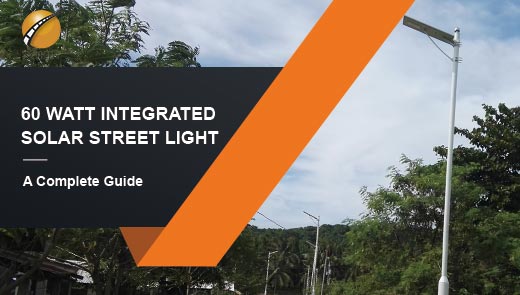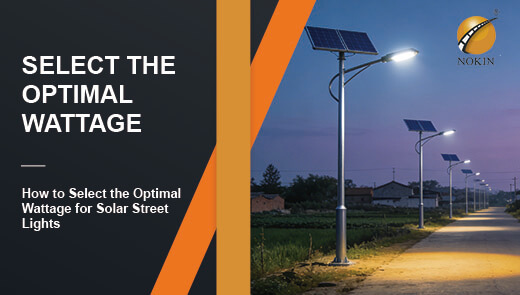Understanding LED Light Temperatures for Solar Street Lights
In the field of outdoor lighting, the light efficiency of solar street lights does not only depend on brightness, the choice of light color temperature has a direct impact on safety, energy efficiency and environmental experience. As the core indicator of light color, Kelvin (K) value is like the "temperature code of light", from warm golden yellow to cold snow white, different values correspond to very different application scenarios. In this article, we will analyze the scientific logic and practical selection strategy of LED light color temperature to help you make accurate decisions in solar street light projects.
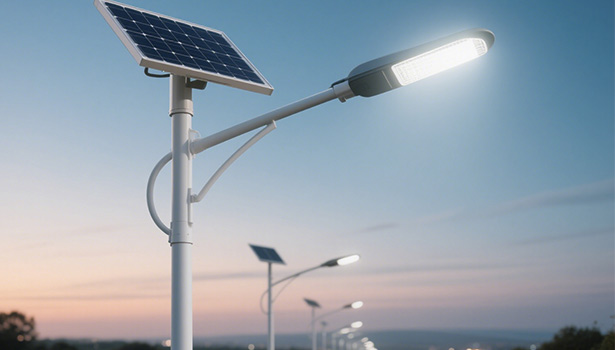
Understanding Solar Street Light Color Temperature ( CCT ): Kelvin
Kelvin (Kelvin, K) as a description of the color characteristics of the light source of the core physical unit, its theoretical roots from the physics of the "blackbody radiation " phenomenon -- when an absolute blackbody is gradually heated, the color of its radiated light will change regularly as the temperature rises: at low temperatures (e.g., 2000K-3000K), the blackbody radiates warm red or orange-yellow light, similar to that of a bonfire or twilight; as the temperature rises to 4000K-5000K, the color of the light will change regularly. As the temperature rises to 4000K-5000K, the light color gradually tends to be close to the neutral white light of the noonday sun; when the temperature breaks through 6000K, the radiated light is inclined to cold blue-white light, which is close to the color qualities of the clear sky.
Types of LED Light Temperatures for Solar Street Lights
Warm White(2700K-3000K)
The light color is characterized by a soft golden-yellow light that resembles the afterglow of the evening and conveys a sense of warmth. Used in residential streets, it can reduce light pollution and create a livable environment; used in park trails, it can match the landscape design and create a relaxing atmosphere; it is also extremely suitable for use in low-traffic areas, such as community alleys and yard lighting. Its core advantage is to reduce insect attraction, as short wavelength yellow light has low attraction to insects and is highly penetrating in rainy and foggy weather, due to longer wavelengths and less scattering loss. However, it also has limitations, with lower brightness, making it less suitable for high vehicle speeds or high-traffic scenes.
Neutral White(3500K-4500K)
The light color is close to midday natural light, without obvious color deviation, and the visual experience is comfortable. In commercial streets, it can take into account the safety of pedestrians and store color reproduction, because commercial scenes need a high color rendering index CRI to accurately present the color of the goods; parking lot using this light color temperature, can provide uniform illumination, to avoid visual fatigue; hospitals, factories and other workplace scenes, the neutral white light can maintain visual clarity and a sense of softness. Its core advantage is accurate color reproduction, suitable for scenes that require color recognition, such as identification of traffic signs, commodity display, etc., and a wide range of applications, can be flexibly matched with different architectural styles.
Cool White(5000K-6500K)
Presents a bright blue-white light, simulating the sense of high brightness of a clear sky. On highways, it can enhance the contrast between the road surface and obstacles, reducing the accident rate; in industrial plants, it can ensure high visibility of large machinery operation areas; in security areas, such as warehouses, airports and the surrounding area, cool white light can enhance the clarity of the monitoring screen. Its core advantages are extremely high contrast, clear shadow performance, suitable for dynamic visual needs, and a strong sense of modernity, in line with the trend of urban technological lighting. However, it has its limitations. Long-term direct vision can cause visual fatigue, so it is necessary to control the glare.
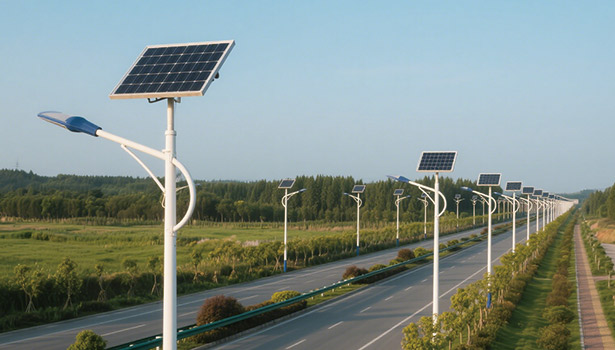
Why Color Temperature Matters
Visibility and Safety
In high-risk traffic scenes, the precise choice of light color temperature is directly related to public safety. For example, 5000K-6500K cool white light is the preferred solution for highway and intersection traffic areas. This type of light color temperature by simulating the high brightness characteristics of midday light (brightness up to 3000-6000lux), significantly improve the road markings, obstacles and background environment contrast, tested to make the driver's reaction speed at night increased by about 15%, effectively reducing tailgating, lane departure and other accidents.
In foggy areas, rainy and other adverse weather conditions, 2700K-3500K warm white light or neutral light is more advantageous. The core principle lies in the fact that the wavelength of warm white light is concentrated in 570-590nm (yellow light band), compared with the 450-495nm (blue light band) of cold white light, the scattering loss in water vapor is reduced by more than 30%, and the penetrability is stronger. Measurement data shows that 3000K warm white light in the visibility of less than 50 meters in the fog, the effective illumination distance than 6000K cold white light increased about 25 meters, significantly improving the driver's field of vision.
In special functional areas, such as roads around airports, the international lighting standard (CIE S025) explicitly requires that the color temperature of street lights be ≤4000 K. This is because cold white light above this value may produce high-intensity glare, which interferes with the visual judgment of pilots during takeoff and landing, especially at night or in low-cloud weather, and the excessive blue light will exacerbate the reflections on the cockpit dashboard, which will increase the risk of operation. By limiting the color temperature and combining with anti-glare lens design, light pollution can be controlled within the safety threshold, ensuring the safety of both aviation and ground transportation.
Energy Efficiency
From the perspective of energy consumption, there is a difference in power consumption between LED luminaires with different light color temperatures at the same brightness, but this difference is mainly related to the "brightness demand" rather than the color temperature itself. Warm white (2700K-3000K) consumes less power, typically 20-30W (at the same brightness). Due to its lower brightness requirements, the configuration of solar panels and energy storage systems is more flexible, suitable for small-scale lighting projects or scenes that do not require high brightness, such as courtyards and walkways. This light color temperature creates ambiance through soft warm light while reducing energy consumption, which is a perfect match for low-intensity lighting needs.
Neutral White (3500K-4500K) has a medium power consumption of about 30-40W, balancing brightness with energy efficiency. It is suitable for most conventional scenes, such as commercial streets and parking lots, and can be efficiently matched by optimizing solar panel area and battery capacity. Neutral light provides sufficient visual clarity while avoiding excessive energy consumption, making it an ideal choice for balancing practicality and economy.
Cool white (5000K-6500K) has relatively high power consumption, usually 40-50 W. This is because cool white light needs higher brightness to take advantage of its high visibility, so it needs to be paired with high-efficiency solar panels (such as monocrystalline silicon panels) and high-capacity storage batteries, and it is suitable for scenarios that have stringent requirements on light intensity, such as highways and industrial plants. It is worth noting that the energy efficiency of LED itself is much higher than that of traditional light sources (such as high-pressure sodium lamps), and the "high power consumption" of cool white light is essentially a result of meeting the demand for high brightness, rather than a difference in efficiency due to color temperature.
Modern solar LED technology has been optimized for energy consumption through multiple innovations. In terms of optical design, through the lens precise light distribution to reduce ineffective light scattering, so that the light can be concentrated in the effective lighting area, such as the beam angle control within 60 °, to avoid the waste of light; Intelligent control system combined with the solar energy dynamic management system, according to the length of sunlight and the state of the energy storage to automatically adjust the output power. For example, when the traffic flow is reduced late at night, the brightness of the cold white light is automatically reduced to avoid the waste of energy consumption caused by "excessive lighting"; Chip technology upgrades using flip chip, nano optical coatings and other processes to improve the luminous efficiency, so that the cold white light in the same power consumption to achieve a higher brightness.
Therefore, there is no need to exclude cool white light due to "power consumption" when choosing light color temperature, the key is to match efficient solar components and intelligent control solutions according to the brightness requirements of the actual scene, so as to realize "supplying light on demand and maximizing energy efficiency". For example, in the highway scene, despite the high power consumption of cold white light, its value of reducing the accident rate through high visibility far exceeds the increased cost of energy consumption, and ultimately optimizes the overall benefits.
Aesthetic Appeal
In historic districts, warm white light (2700K) with vintage lamps can restore the nostalgic atmosphere; in commercial complexes, neutral white light (4000K) can highlight the modernity of the building and enhance the effect of brand display; in ecological parks, it is necessary to limit the high-color temperature lighting to avoid interfering with plant and animal rest and recuperation, for example, insects tend to be phototropic, bird migration and other behaviors will be affected by high color temperature lighting. The behavior of insects and birds will be affected by high color temperature lighting.
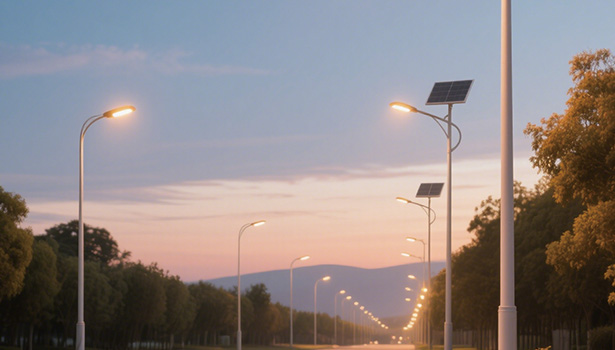
Choosing the Right Color Temperature for Your Solar Street Lighting Project
Highways and Main Roads
The recommended color temperature is ≤5000K, with a preference for 5700K cold white light. The EU standard recommends a color temperature of ≤4000K to reduce glare, but some states in North America allow 5700K or higher to improve visibility. In practical applications, anti-glare lenses are required to avoid dazzling the drivers of oncoming vehicles and to ensure traffic safety.
Residential and Community Roads
Recommended color temperature ≤ 4000K, can choose neutral white or warm white. This can balance pedestrian safety and residents' rest needs, and avoid the "light aggression" of cold white light. For example, in some communities, choosing 3000K warm white light can reduce the impact of nighttime lighting on bedrooms and create a comfortable nighttime environment for residents.
Commercial Streets and Parking Lots
Recommends cool white light with a color temperature of 5700K-6500K. Parking lots need high brightness lighting to prevent safety hazards, cool white light can enhance the identification of license plates and obstacles. In commercial areas, it is recommended to match high CRI (≥80) light source to ensure that the color of the goods is truly presented, attracting customers' attention and promoting commercial activities.
Rainy and Foggy Areas
Recommend 2700K-3500K warm white or neutral white. The scientific basis lies in the fact that yellow light wavelength (570-590nm) has a 30% lower scattering rate in water vapor than blue light (450-495nm), which makes it more penetrating. The use of street lights with the appropriate color temperature in these areas can effectively improve visibility in rainy and foggy weather, and protect the safety of pedestrians and vehicles.
Industrial Parks and Warehouses
Recommends a cool white light of 5000K-6500K. In large-scale machinery operation areas, need to clearly identify the contours of the equipment and instrumentation readings, cool white light of high contrast advantage is significant, can improve work efficiency, reduce operational errors, to protect the safety of industrial production.
Garden and Landscape Lighting
Recommends 2700K-3000K warm white light. Warm light can highlight the texture of plants and architectural silhouettes, avoiding the cold white light to destroy the quietness of the natural night landscape, adding a soft, warm atmosphere for gardens and landscapes, and enhancing the viewing experience.
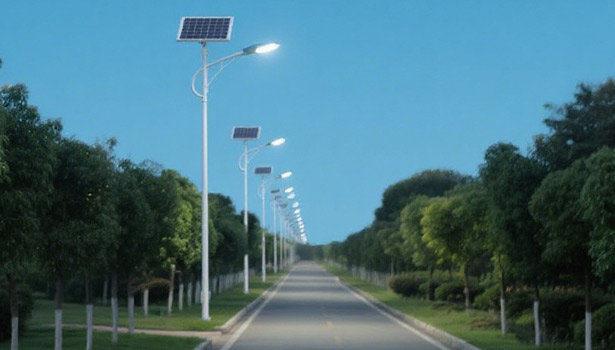
3 Common Myths About LED Light Color Temperature Debunked
Myth 1:"The brighter the cool white light, the safer it is, and it should be used across the board"
The truth is that the overuse of cool white light may lead to the "light curtain effect ". In wet roads and other situations, the strong light in the road surface to form a reflective layer, but reduce the obstacle recognition, increase the risk of driving, so it is not the brighter the cool white light is the safer, need to be based on the actual scene reasonable choice.
Myth 2:"Warm white light has low energy efficiency and is not suitable for solar energy system"
In fact, LED energy efficiency is determined by the chip technology, and the luminous efficiency of warm white light and cold white light is close to the same power. The core matching point of the solar system is "brightness demand and panel capacity balance", rather than the color temperature, warm white light in the right scene can also achieve high efficiency.
Myth 3:"The higher the color temperature, the longer the service life"
LED lifespan is mainly affected by the heat dissipation and the driver power supply, the color temperature is not directly related to the life. If the cool white light lamps have poor heat dissipation, the chip temperature may be too high to shorten the life, so we can not simply think that the higher the color temperature, the longer the service life.
Frequently Asked Questions
Q1: Is it possible to replace LED modules with different color temperatures in existing solar street lights?
Most modern luminaires support modular replacement, but it is necessary to pay attention to the interface compatibility and the power matching of the original driver power supply. Before replacing, you should carefully check whether the new modules are compatible with the parameters of the existing lamps and lanterns to ensure that the lamps and lanterns can work normally and stably after replacement.
Q2:Why do some countries restrict the color temperature of street light to be higher than 4000K?
Mainly based on the following risk control:
Light pollution: the blue light component of high color temperature light (>480nm) is easy to produce sky glow, which interferes with astronomical observation (such as the suburbs of the city around the Observatory need to be strictly limited).
Health effects: long-term exposure to high color temperature artificial light may inhibit the human body's melatonin secretion, which affects the circadian rhythm (World Health Organization WHO recommends that nighttime lighting color temperature should not exceed 4000K). The World Health Organization (WHO) recommends that the color temperature of nighttime lighting should be ≤4000K.
Glare Hazard: 5000K or more of cold white light is prone to "Mie scattering" in rain and fog, forming a light curtain effect, which in turn reduces visibility.Example of regulations: EU "Outdoor Lighting Guidelines" (EN 13201) stipulates that the color temperature of street lamps in residential areas shall not exceed 4000K, and the restriction is relaxed to 5000K in commercial areas, but it is necessary to install anti-glare grills.
Q3: How to reduce the glare problem of cool white light?
Priority is given to lamps with optical lenses, controlling the beam angle ≤ 60 °, and adopting half cut-off design to avoid upward light spill. Through reasonable optical design and luminaire structure selection, it can effectively reduce the glare of cold white light and improve the comfort and safety of lighting.

